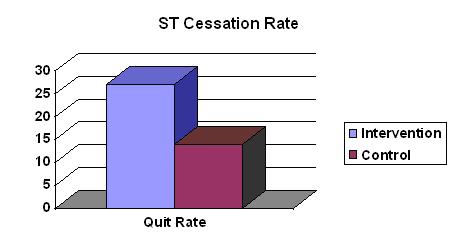Program Synopsis
Designed to promote cessation and reduce initiation of spit tobacco use among male high school athletes, this intervention consists of two parts: (1) a single peer-led group session that includes a discussion on media influences, a slide presentation, and video and (2) a dental component that includes an oral exam and, for active spit tobacco users, a brief counseling session and follow-up call. The study showed a higher quit rate of spit tobacco.
Program Highlights
Program Materials
Preview or download materials
Program Scores
The Need
Oral snuff and chewing tobacco, also known as spit tobacco (ST) are associated with such adverse health effects as oral cancer, oral pre-cancerous lesions, cardiovascular disease, periodontal disease, and nicotine addiction. The overall prevalence of ST use is 14% among all high school males, and 19% among White high school males. High school males most frequently use ST when playing or watching sports. Moreover, the greater their athletic involvement, the greater their likelihood of ST use. Among college baseball players, ST use prevalences are 45-50%; almost one-half of college baseball athletes who use ST began during high school.
The Program
The program aims to promote cessation and reduce initiation of spit tobacco use among male high school baseball players. Based on cognitive social learning theory, Spit Tobacco Intervention (STI) consists of two parts: a single session peer-led component, and a dental component. The peer-led component includes a discussion of media and industry influences, a slide presentation, and a video. The dental component includes an oral exam from a dentist and, for spit tobacco users, a brief counseling session to establish a quit date and a follow-up phone call by a dental hygienist to discuss the quit date.
Time Required
The peer led component of the intervention lasts approximately 60 minutes; the dental component includes an oral examination for spit tobacco users in which a 15-minute brief counseling session and one 5-10 minute follow-up phone call are also required. Dentists and hygienists require a 1-day training workshop and peer leader trainings require a 2-hour training workshop.
Intended Audience
Participants were male high school baseball athletes; 28% were current spit tobacco users, and 11% were cigarette smokers.
Suitable Settings
This intervention is suitable for implementation in the high school.
Required Resources
Required materials include: the STI overview, peer leader training guide, dental interventionist training guide, posters, 14 slides, and the "Baseball Peer Athlete Training Video," containing two other short movies, "A Dangerous Game," and "A Tragic Choice: the Bob Leslie Story." Costs associated with the program's implementation are not provided.
About the Study
Forty-four randomly selected rural California high schools were assigned to either the intervention or control condition. The intervention consisted of two components: 1) a peer led component, and 2) a dental component. The peer led component consisted of a single, interactive, 50 to 60-minute educational team meeting at the school and was presented in three segments: a videotape presentation and discussion, a presentation of 10-16 slides, and a small-group discussion on tobacco industry advertising. The dental component included an oral cancer screening by a dentist and was followed by a brief counseling session on tobacco cessation for students who were active spit tobacco users. Saliva samples were collected from subjects at the beginning of the study to encourage honesty in self-reports of ST use.
Results indicated:
-
One-year post intervention, the quit rate was 27% at intervention high schools and 14% at control high schools.

- The intervention was most effective in promoting cessation among those who, at baseline, lacked confidence that they could quit, among freshman, and among nonsmokers.
- The intervention did not reduce ST initiation.


